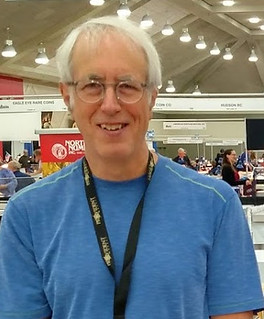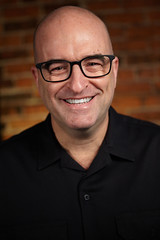
PREV ARTICLE
NEXT ARTICLE
FULL ISSUE
TOM CALDWELL INTERVIEW, PART TWOGreg Bennick's latest interview for the Newman Numismatic Portal is with Tom Caldwell of Northeast Numismatics. Here's the second of four parts, where Tom discusses the coin business, grading services, and error coins. -Editor GREG BENNICK: So, one thing that I'm interested in is, and I do want to get into something that you mentioned, I do want to get into security and whatnot and safety and whatnot. Because you brought that up. But one thing I want to mention that's completely different. I grew up in Connecticut, and going to coin shows, Auburn, Massachusetts, Polish National Home, all these shows in the 80s and the early 90s, I was amazed to move out to Washington, where I live now, and find that there's no colonial coins, for example. Whereas if you go to a coin show in the Northeast, there's colonial coins everywhere. And I was really fascinated about the regional nature of coin collecting. Do you encounter, I'm assuming you do, lots of people who are involved with colonial coins? And how much of that market takes up your time? Because out here in Washington, you could go to a coin show and not see even one colonial coin, which amazes me.
GREG BENNICK: Yeah. And I think that what maybe has transpired, and I'm just guessing, is that there's people, I know that I'm connected to colonial New England roots, having grown up in Connecticut. But people out here simply are not. So maybe the connection to collecting that has not become as popular here. I mean, I might have overstated that there'd be no colonial coins at a show. There just wouldn't be the preponderance of them that you see at a show, say, in Boston or New Hampshire. TOM CALDWELL: That sounds right. And I think there's also more dealers from this part of the country that are likely to have some colonials. But yeah, so that sounds right. Honestly, we've always dealt in everything from colonials to territorial gold and everything in between. Just enjoy the variety.
TOM CALDWELL: Well, I could say the next deal I'm going to make some good money on, but something in particular, we have always gone towards, always enjoy mint errors. That's been a favorite. Early coins, as you mentioned, can't go wrong with early coins, early Americana. So, I would say those would be a couple of particular ones. GREG BENNICK: And I will offer an endorsement that the mint error selection on your website is always top notch. And I just always see things there, every once in a while, find something to buy. But there's always an amazing selection of mint errors on your site. TOM CALDWELL: Well, thank you. Yeah, we'll try to keep up the good work. GREG BENNICK: Now, one thing that you do on your site, which is really interesting, is that you allow people to make offers at times on certain coins. Can you tell me about that and how that came about?
TOM CALDWELL: Sure. Well, our site is largely treating it somewhat like a
coin show. And we want the inventory to keep moving. So, after a certain number
of weeks, there'll be something that they can click - or something underlined -
where someone looking at our site can see they're allowed to make an offer. And
we'll come back at our best price or it might be negotiated further. And we get a lot
of compliments on folks that just like that fact. We're not going to be hard-headed
about it, GREG BENNICK: I'm glad. I know that there are specific things that I'm looking for that I have alert messages set with you. That every once in a while, I'll get an alert and I'll go and look at the coin. And there was one Standing Liberty quarter that I think I bought within a minute of you sending the alert last time. So, I enjoy that very much.
TOM CALDWELL: That works also. It's easy to say, GREG BENNICK: What is it about mint errors that you've been attracted to over the years? Because I'm a mint error collector, certainly. What is it about mint errors that you've liked? You mentioned that first. TOM CALDWELL: Well, just the oddity of them. Every one is different, essentially. It's a specialized field, but we've always enjoyed dealing with them pretty much no matter what they are. The varieties and the mint errors. GREG BENNICK: Great. Now, I was going to ask, and this is almost like a general question in a way, but I would love your perspectives on it. The timeline of the hobby since you started collecting and the sort of changes and highlights and fads and trends that come up, I would just love to know from your perspective, what are the things that jump out to you most say, about coin shows and how they've changed, or we could talk about grading trends as well. You don't have to combine them into one answer. But I'm just curious about the changes you've seen over the years and how it's impacted your perspectives on the hobby. Say if we were to talk about grading, for example, and how that's changed over the last 40-some years, what are your perspectives on that? Or your thoughts about grading and where we're at and where we've been? TOM CALDWELL: Yeah. Well, I think PCGS and NGC coming along as a major grading services have been good for the business. It used to be somebody would call up and say, what does the coin look like? And I'd say, well, hold it up to the phone and we'll tell you a little bit closer (laughter) But now, I mean, with the standardized grading, everybody taking into consideration the | to 70 scale, it's only helped our business. It's eliminated some shysters out there that back in the day could just call coins whatever they wanted to. And with that said though, there have been some changes along the way where the standards have like loosened up a little bit. Not something the grading companies would really admit, but it used to be like a deep dark secret, but now it's pretty well known. But there's been adjustments to that. And while we're talking about grading, of course, I think that was the major thing over the years that really changed the business. Introduction of the grading services. And you have to give David Hall an awful lot of credit for coming up with that originally. And even just as important is the registry sets. That wasn't so much that he came up with the idea of putting the coins in the holders. It was also that he came up with a registry set for this. He's got tens of thousands of people competing with each other out there. That's been a big plus. GREG BENNICK: People love competition. They certainly do. And they love it in any way. So, whoever would have thought that we could compete with coins. It's really interesting. TOM CALDWELL: That's right. GREG BENNICK: So, you're talking about gradeflation, as people say, and the inflation over time. It's interesting. What do you think has caused that? It's easy to surmise maybe, but I'm not exactly sure. What do you think has caused that gradeflation? If you and I were standing around in 1986 with a display of Morgan dollars, say, and $10 gold pieces in front of us, all uncirculated. Those would grade differently than, say, if we did the exact same exercise today, perhaps. What do you think has caused that? TOM CALDWELL: Well, I think part of it has been that coins have gone up in price a lot. So, when, let's say, a $50 coin back 40 years or so ago might be a $500 coin today, there might be a tendency to grade things a little bit different and to refine it. That's why there's signs that came along about probably 15 years or so ago and other such designations that the grading services have had. GREG BENNICK: Yeah. It seems that the addition of a plus or star certainly has added to the numerical grading scale, certainly. Of course, that gradeflation you mentioned earlier, that it seemed to be metered a bit. Meaning, have you noticed that people are aware of that and they've made changes? And I don't mean to single out any grading company in particular, but we all do it. I'm sure that grading standards have shifted for all of us. Have you noticed maybe a pulling back on the flexibility of grading recently at all? TOM CALDWELL: I would say to some degree that's true. And I mean, it's long been said that grading it's not an art. It's subject to people's interpretation of what it is. So, it's just likely to change over time. And also, with dealers submitting coins for walkthrough service, might be some tendency for the graders to want to give it a little extra grade over time. But I think it has evened out. If we jump way to the future, of course, there's a new CAC grading service, John Albanese, who has not been happy with the way coins are graded. It's interesting to see how that will play out. GREG BENNICK: I'm definitely interested. Have they started as of now, March 2023, have they started grading coins yet? I don't think they have. TOM CALDWELL: They have not. I mean, they keep on putting it off because they want to get it right, supposedly. They said it would be before the end of last year, but now it's probably a few months out, I'm guessing, but we shall see.
To watch the complete video, see:
To read the complete transcript, see:
To read the earlier E-Sylum article, see:
Wayne Homren, Editor The Numismatic Bibliomania Society is a non-profit organization promoting numismatic literature. See our web site at coinbooks.org. To submit items for publication in The E-Sylum, write to the Editor at this address: whomren@gmail.com To subscribe go to: https://my.binhost.com/lists/listinfo/esylum All Rights Reserved. NBS Home Page Contact the NBS webmaster 
|



